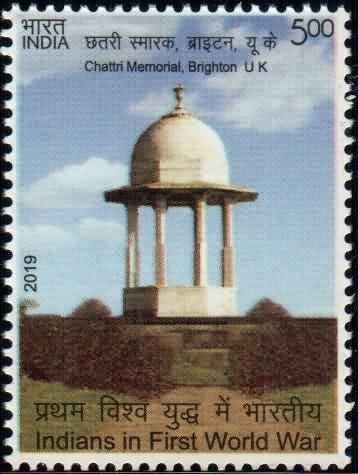Chattri Memorial, Brighton, UK

Technical Data
| Stamp Set | India in World War I : Indian War Memorials |
|---|---|
| Date of Issue | August 20, 2019 |
| Denomination | Rs. 5 |
| Quantity | 500,000 |
| Perforation | 13¾ x 13¼ |
| Printer | Security Printing Press, Hyderabad |
| Printing Process | Wet Offset |
| Watermark | No Watermark |
| Colors | Multicolor |
| Credit (Designed By) | Sh. Brahm Prakash |
| Catalog Codes |
Michel IN 3552A Stamp Number IN 3140 Yvert et Tellier IN 3235 Stanley Gibbons IN 3635 |
| Themes | First World War | Monuments |
The Chattri Memorial in Brighton, United Kingdom, stands as a poignant reminder of the courage, sacrifice, and service of Indian soldiers who fought during the First World War (1914–1918). Located on the serene South Downs overlooking the city of Brighton, the Chattri marks the site where the bodies of Hindu and Sikh soldiers who died in the hospitals of Brighton were cremated with full military honours.
Historical Background
During the First World War, thousands of Indian soldiers were brought to Britain from the Western Front for medical treatment. Several hospitals were established in Brighton, including the Royal Pavilion, the York Place School, and the Kitchener Hospital, specially adapted to care for wounded Indian troops.
Out of the many soldiers treated there, 74 Indian soldiers lost their lives. The Hindu and Sikh soldiers were cremated on the Downs at Patcham, while Muslim soldiers were buried in a separate cemetery at Woking, Surrey. The site of their cremation later became the location of the Chattri Memorial.
Design and Symbolism
The Chattri, meaning “umbrella” in Hindi, Punjabi, and Urdu, symbolizes protection and honour. Designed by E.C. Henriques, an Indian architect, the memorial is built from white Sicilian marble and stands 29 feet high. It was unveiled on 21 February 1921 by the Prince of Wales (later King Edward VIII).
The structure combines Indian and European architectural styles, featuring three marble domes supported by elegant columns — a reflection of India’s cultural heritage and the bond between India and Britain during the war. The names of the fallen soldiers are inscribed on a separate plaque at the foot of the hill.
A Tribute to Indian Soldiers
The Chattri Memorial honours the sacrifice of the Indian soldiers who served on the Western Front in Europe — in France, Belgium, and other battlefields — and who later succumbed to their wounds in Brighton’s hospitals. These men came from diverse regions and regiments of India and fought with courage in some of the most difficult campaigns of the war.
Every year, a memorial service is held at the Chattri, attended by representatives of the Indian Army, British armed forces, and members of the Indian community in the UK, reflecting the continuing respect and gratitude for their bravery.
Legacy
The Chattri Memorial remains one of the most significant sites in Europe commemorating Indian soldiers of the First World War. It serves as a symbol of India’s vital contribution to the global conflict and as a bridge of shared history between India and Britain.
Peaceful and majestic, standing amidst the rolling hills of the English countryside, the Chattri continues to echo the timeless message of honour, remembrance, and sacrifice.

Leave a Comment
You must be logged in to post a comment.